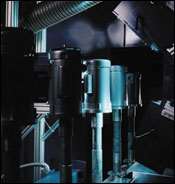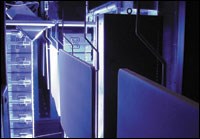UV Powder Reaching New Markets
UV powder coating is starting to gain some popularity among finishers as they see the ability of UV to open up new markets for them...
Powder coating has long been used to coat metal parts because it is an efficient, no VOC, single-coat process that provides a high-quality, durable finish. Many types of parts are commonly powder coated, including lawn and garden, appliance, automotive and architectural. However, powder coating has several disadvantages that have kept it from being used for some applications. Two of these disadvantages are the high temperatures and long dwell times required to melt, flow and cure the powder. Typical curing schedules are 320-390F for 20-60 min depending on part size and shape. This has typically limited the application of powder to metal parts that could withstand these conditions and slowed throughput for massive metal parts.
UV Powders
Ultraviolet (UV) curable coatings, inks and adhesives have been used in a variety of industrial applications for more than 30 years, from beverage can coatings to printing inks to overprint varnishes. UV curable powder coatings now make it possible to powder coat parts such as medium density fiberboard (MDF), plastics and preassembled and diecast metal parts. Plastics are difficult to powder coat because they are both heat sensitive and nonconductive. Additionally, galvanized and electroplated substrates that tend to outgas or are temperature sensitive can now be powder coated with less concern about the likelihood of coating defects.
UV powder coatings may also be a better option for massive metal parts, such as engine blocks, iron light pole bases, and I-beams, that act as a heat sink during processing. With a traditional powder coating, the part surface must remain at high temperature to ensure adequate cure of the heat-activated powder. But, a massive metal part absorbs the heat, which results in high energy costs and long oven dwell and cool down times. Since the UV powder is not heat activated, both the oven temperature and dwell times can be reduced. This offers finishers new options and provides the opportunity for traditional custom powder coating firms to expand their markets.
Featured Content
Unlike traditional powder coatings, UV powder coatings have a component called a photoinitiator, which is sensitive to UV light. When the photoinitiators in the powder coating are exposed to UV light, they form free radicals that initiate the polymerization process. So, one advantage of a UV powder is that the melt and flow can be totally separated from the curing, allowing superior flow out and leveling of the coating prior to crosslinking. Most UV powders melt and flow in IR, convection or IR/convection combination ovens at 175-250F for 2-10 min. Then they are cured in a UV oven in a matter of seconds.
Performance properties of UV powder coatings frequently exceed those of liquid and traditional powder coatings. For example, one manufacturer's UV powder for metal can be formulated in glosses ranging from 60 to 100 units. Staining agents applied for 24 hr resulted in no effect with coffee, mustard, ketchup or alcohol. On iron phosphated steel, salt spray performance (ASTM B117) at 1,000 hr resulted in 0.125-inch creep or less. Solvent resistance was 50 double rubs (MEK) without effect. Another manufacturer's UV powder has been tested on both yellow chromated (Cr+6) aluminum and electrolytic chromium coated steel. These tests showed excellent adhesion (ISO 2409), impact resistance (ASTM D2794) and T-bend (ASTM D4145) results. Corrosion results were good too, passing copper accelerated salt spray tests (ASTM B368) and the filiform corrosion test (GSB test). Weathering test results also were satisfactory via both accelerated QUV-A (ASTM G53) testing and Florida natural weathering standards testing.
Both textured and smooth coatings are available in a variety of colors, although not as many colors are available as with traditional powders. Typical coating thickness ranges from 1.5-4.0 mils depending on the appearance and performance properties required.
Process Considerations
Typically UV curing is a very fast, low temperature process that requires little floor space and produces high-quality coatings. Thus, with a UV powder we get the best of both worlds-high material utilization, no VOCs, increased productivity, reduced floor space, low-temperature curing and a high-quality coating.
UV light is produced by industrial grade ultraviolet emitting lamps, either electrode arc type or electrodeless microwave-powered lamps. These UV light sources are manufactured to withstand industrial plant environments and require little maintenance aside from regular cooling air filter changes, periodic reflector cleaning and bulb replacement. Microwave-powered electrodeless lamps have been installed on the UV powder lines in North America due to their longer life, stable energy and wavelength output and modular design, which allows positioning of individual lamps for 3D curing.
UV powders currently cost several times more than traditional powder coatings. However, costs are expected to drop as production volumes increase. Anyone evaluating whether to use UV powder should remember to factor in this likelihood. One must take into account the cost-effectiveness attributable to high material utilization as well. Just comparing the cost per pound will lead to potentially erroneous conclusions. Another cost factor to consider is that the floor space will be reduced, so the new plant footprint can be smaller or capacity increased without adding additional floor space. Line speeds will be faster, so productivity will be increased. Typically there will also be labor and energy cost savings. All of this must be considered when evaluating UV powder. A good cost analysis will compare the cost to coat each part factoring in all these variables.
A typical UV powder coating line may have a preheat oven and a melt/flow oven. Occasionally a single oven can fill these two roles. There are at least two reasons for installing a preheat zone. First, if positioned at the entrance to the flow-out zone, it minimizes the likelihood of powder becoming airborne and acting as a contaminant in the flow-out zone. Second, when located before the application area, it assists in powder deposition on non-conductive parts. The amount of preheat required depends on the part size and shape. In some applications it may be possible to use the heat from formation of the part, say following extrusion, molding or fiberglass pultrusion, to melt and flow the powder, eliminating the need for both preheat and melt/flow ovens.
It may be possible to retrofit an existing powder coating line with a UV curing oven. If the part is hot enough following formation, then the addition of powder spray equipment and the UV curing units may be all that is needed. It is important to work closely with a knowledgeable finishing system supplier and, ideally, a team that includes the UV powder supplier and UV equipment supplier to help you begin evaluating the possibilities.
H&G Powder Painting
H&G Powder Painting (London, Ontario, Canada) is a custom powder coater with three powder coatings lines. The company powder coats metal products for automotive, hardware and lawn and garden customers. About three years ago, Glen McLean, general manager at H&G, and Rick Grim, plant manager, met with Fusion UV Systems and a powder formulator to learn more about UV powder coating. Mr. McLean said he was interested in UV powders because, "It would enable us to expand our powder coating capabilities to other substrates, such as wood, preassembled parts and other heat sensitive substrates. I looked at low-temperature thermal cure powder coating, but UV powder provides a more durable finish, provides more flexibility and is faster."
In fact, the two managers visited the UK to see the first UV powder on MDF line in Wales at Stilexo Ltd. and an early, if not the first, low-temperature thermal cure powder line in England at Acre & Associates. Mr. McLean stated, "Things seemed to move slowly over the three years. But just in the last year everything really seems to be coming together. The raw material companies offered more to formulators. Now the formulators are all investing heavily in developing UV powders. Then the equipment suppliers developed UV powder finishing systems to complete the puzzle."
The system incorporates one spray booth, one oven and 14 microwave-powered F600 UV curing lamps. Mr. McLean presented the proposed UV curing line to Ken Giles, owner of H&G. Mr. Giles liked the design flexibility UV powder brought to wood furniture. He was also convinced that it was the best coating at the lowest cost and may even replace some liquid coatings.
H&G purchased a 30,000-ft2 facility and installed the system in August, 2001. The company is marketing its services initially to the office furniture industry, but it is not limiting itself to MDF substrates. The line is flexible enough to cure many different sizes and shapes, and H&G expects to gain customers with plastic and glass as well as heat-sensitive preassembled parts. The company also thinks UV powder will be a better option for some metal parts that are currently powder coated, such as massive metal parts, castings and galvanized and electroplated parts.
It's a good idea to do a preliminary feasibility study to determine some basic parameters, such as line speeds, capital costs and operating costs. Once you have approval from management based on the feasibility study that such a system may make sense for your operations, then work with a finishing system integrator who can help you decide on retrofit versus new line options. Lab trials will tell you and/or your customer if the UV powder can meet your coating requirements and help quantify the operating conditions. Based on the lab trials, you can then get quotes for capital equipment and begin the detailed evaluation process.
To learn more visit Heraeus Noblelight America LLC.
RELATED CONTENT
-
Preparation of Stainless Steel for Powder Coating
Should type 316 stainless steel castings be sandblasted before powder coating, or can they be chemically etched? Should the parts be pre-heated in an oven before coating?
-
Curing Oven Basics
Simply heating up the substrate does not cure the coating. There are many variables to consider when choosing the best cure oven for your application...
-
Improving Transfer Efficiencies in Coating Operations
There are many methods for addressing electrostatic grounding in metal painting processes, and Tim Ulshafer from Mueller Electric says the best method for your process is a simple and worthwhile exercise.




















